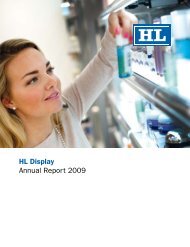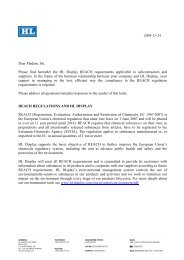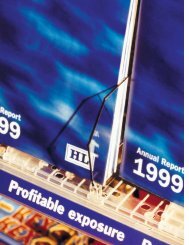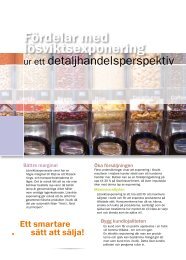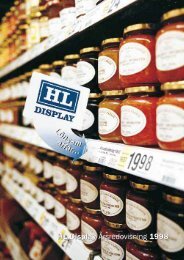Annual Report 2004 - HL Display
Annual Report 2004 - HL Display
Annual Report 2004 - HL Display
Create successful ePaper yourself
Turn your PDF publications into a flip-book with our unique Google optimized e-Paper software.
Financial instruments<br />
An explanation of the accounting principles in respect of financial instruments<br />
is provided in note 2.<br />
Hedging<br />
Most of the foreign subsidiaries’ net values of monetary assets and monetary<br />
liabilities are hedged, as are most of the parent company’s loan receivables<br />
from foreign subsidiaries. Currency effects of the hedging instruments are<br />
offset against the translation difference that arises on conversion of the foreign<br />
subsidiary’s income statements and balance sheet, and against exchange rate<br />
differences in the parent company’s loan portfolio.<br />
Inventories<br />
Inventories are valued at the lower of acquisition value and market value.<br />
Balanced average prices are applied to calculate the acquisition value. Products<br />
manufactured by the company and products in progress are valued at the<br />
manufacturing cost including a reasonable proportion of indirect manufacturing<br />
overheads.<br />
Fixed assets<br />
Depreciation according to plan is based on the original acquisition value and<br />
the estimated utilisation period as follows:<br />
– IT systems 4 years<br />
– Goodwill 5 years<br />
– Buildings 33 years<br />
– Plant and machinery 5 - 12 years<br />
– Inventory, tools, fixtures and fittings 3 - 7 years<br />
– Renovation of other parties’ property 20 years<br />
Write-downs<br />
In accordance with the Swedish Financial Accounting Standards Council’s<br />
recommendation RR 17 Impairment of Assets, the reported values of the<br />
Group’s intangible and tangible fixed assets are tested on the balance sheet<br />
date to determine whether there is any indication of a write-down requirement.<br />
If such an indication is identified, the recoverable value of the asset is calculated<br />
as the higher of value in use and net realisable value. A write-down<br />
is carried out if the recoverable value is less than the reported value. When<br />
calculating the value in use, the future cash flows are discounted at a rate<br />
of interest which before tax takes into account the market’s assessment of<br />
risk-free interest and risk associated with the specific asset. An asset which is<br />
dependent on other assets is included with the smallest cash-generating unit<br />
which generates independent cash flows.<br />
A write-down is reversed if there has been a change in the estimates used to<br />
determine the recoverable value. However, a reversal is made only to the extent<br />
that the asset’s carrying value does not exceed the carrying value that would<br />
have been determined, net of depreciation, had there been no write-down.<br />
Provisions<br />
Provisions are reported in the balance sheet in accordance with the Swedish<br />
Financial Accounting Standards Council’s recommendation RR 16 Provisions,<br />
Contingent Liabilities and Contingent Assets, when the company has a legal<br />
or informal undertaking arising from contingent events in which it is likely that<br />
payments will be required to fulfil the commitment and where it is possible to<br />
make a reliable estimate of the amount to be paid.<br />
37<br />
Earnings per share<br />
Earnings per share is calculated, in accordance with RR 18 Earnings per share,<br />
as the Group’s profit after tax divided by the number of shares. In earnings per<br />
share after dilution the number of shares has been increased by the number of<br />
shares involved in the three option schemes. Dilution only arises if certain conditions<br />
are fulfilled. Dilution does not occur if, for example, the present value is<br />
less than the average share price during the period, or in the case of a negative<br />
result.<br />
Group contributions and shareholders’ contributions<br />
Shareholders’ contributions are posted directly to equity at the recipient and<br />
are capitalised as shares and interests at the issuer, if no write-down is required.<br />
Group contributions are reported according to their financial nature. This<br />
means that group contributions issued or received for the purpose of reducing<br />
the group’s total tax are posted directly to retained profits with a deduction for<br />
its current tax effect.<br />
A group contribution that is equivalent to a dividend is posted as such, i.e.<br />
group contribution received, and its current tax effect is posted in the profit and<br />
loss account. Group contribution issued is posted directly to retained profits<br />
with a deduction for its current tax effect.<br />
A group contribution that is equivalent to a shareholder contribution is for<br />
the recipient posted, with due consideration of its current tax effect, directly to<br />
retained profits. The issuer reports the group contribution and its current tax<br />
effect as shares in group undertakings, if no write-down is required.<br />
Events after the year-end<br />
If any significant events occur after the year-end but before the date on which<br />
the financial reports are signed, and they are not of such a nature that the<br />
balance sheet and profit and loss account have to be changed, the information<br />
is included in the directors’ report or a separate note.<br />
NOTES<br />
<strong>HL</strong> DISPLAY ANNUAL REPORT <strong>2004</strong>




